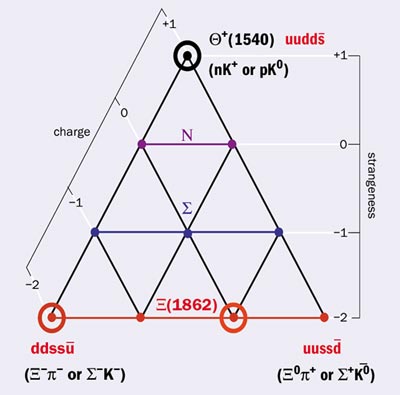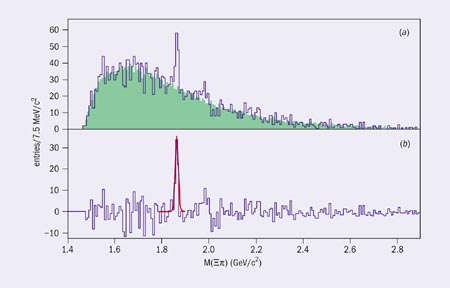
Only a few months after the first burst of excitement over the appearance at several laboratories of what seems to be a new five-quark particle, evidence has been found for a different five-quark state that appears to be closely related.
The constituent quark model of hadrons that was invented in the 1960s has been very successful in describing the known baryons as composites of three valence quarks. Quantum chromodynamics (QCD), the theory of strong interactions, does not forbid baryons containing more than three quarks. In fact, such states were proposed a long time ago but no good candidates were found by experiments until recently. The search was revived by the theorists Dmitri Diakonov, Victor Petrov and Maxim Polyakov. They predicted that the masses of the lightest pentaquark (4q,qbar) baryon multiplet, an antidecuplet (see figure 1), were rather small and that the width of its lightest member was expected to be very narrow (Diakonov et al. 1997). Recent evidence for this state, named Θ+, has opened up a new chapter in baryon spectroscopy that will help to elucidate QCD in the non-perturbative regime. The Θ+ is a manifestly exotic baryon, that is, it cannot be composed of three quarks. This is also the case for the other two corner members of the antidecuplet depicted in figure 1. The latter have a strangeness of S = -2, a charge of Q = -2,+1, and form members of an isospin quartet of Ξ states.

Experiment NA49 at the CERN Super Proton Synchrotron has searched for the Θ+ and the Ξ states in proton-proton collisions at a beam energy of 158 GeV (Alt et al. 2003). Tracks of particles produced in the reactions are recorded by the detector’s four large time-projection chambers. Their high resolution allows for a precise reconstruction of the particle trajectories and momenta as well as their identification via the measurement of the energy loss in the chamber gas. The reconstruction of secondary decay vertices makes possible the observation of the complex decay chains of the pentaquark states. After suppression of the overwhelming background by suitable selection cuts, the summed Ξπ mass distribution shows a narrow peak of 5.6 standard deviations at a mass of 1.862 ±0.002 GeV/c2 (see figure 2). The true width of the peak must be smaller than the observed full width at a half maximum of 0.017 GeV/c2, which is consistent with the resolution of the detector.
In fact, peaks are seen at the same mass in the individual Ξ–π– and Ξ–π+ mass distributions, as well as in those of the antiparticles. No signal has been found yet for the Θ+, for which the background in the potentially observable decay channel pKOs is less favourable. The exotic Ξ— with S = -2, Q = -2 and the Ξ0 with S = -2, Q = 0 are good candidates for the isospin quartet of predicted pentaquark states with quark content (ddssubar) and (dussdbar). Their discovery represents an important step towards the experimental confirmation of the existence of the hypothesized baryon antidecuplet.
Further reading
C Alt et al. 2003 hep-ex/0310014.
D Diakonov et al. 1997 Z. Phys. A 359 305.








